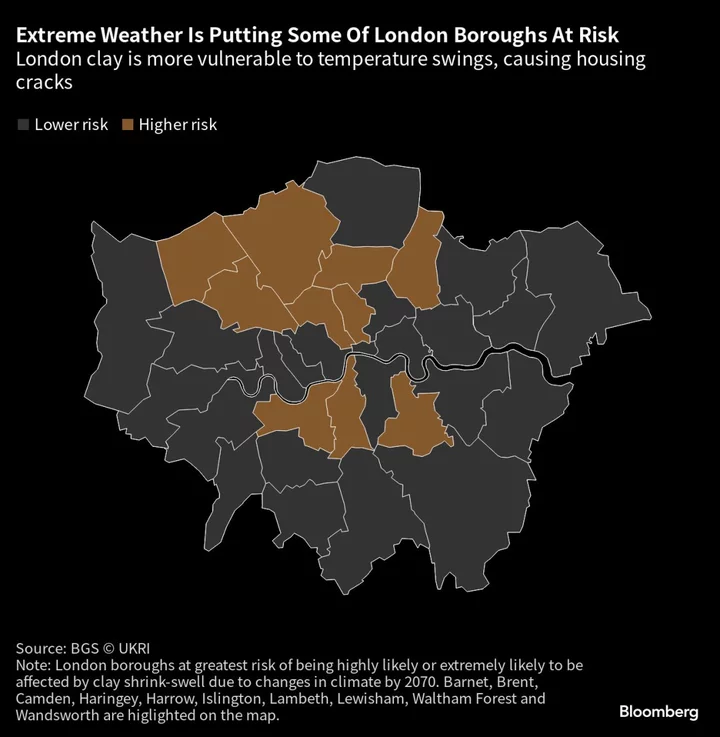Britain’s increasingly extreme weather is shaking the very foundations of its centuries-old history.
The nation has been experiencing prolonged periods of drought after wet winters since last year. That’s causing the porous rock beneath vast parts of southeast of England, including London, to move more than usual, cracking or tilting many of the city’s historical homes in the plushest neighborhoods. The damage has triggered the highest insurance payout in almost two decades, with experts warning that it could get worse.
The London clay, the type of soil that covers most of these areas, “is quite unique” because it can shrink and swell a lot, according to Lee Jones, a geological engineer at the British Geological Survey who has studied UK hazards for over 30 years. “The wetter it gets, the more it swells and expands and the drier it gets, the more it shrinks and cracks,” he said, adding that future temperature extremes will exacerbate the impact on buildings and roads.
That phenomenon — known as subsidence — has become worse in the UK after last year’s drought and a deadly heat wave that pushed temperatures past 40C (104F) in July 2022 to record levels. Heat advisories are out for this summer too, underscoring the vulnerability of London’s historical buildings, some of which have stood since the mid-1800s and survived World War 2, including the Blitz which started in 1940 and saw the city being bombed for months.Read More: UK Heads for Another Sweltering Summer Driven by Global Warming
London Clay is the most susceptible to shrinking among soil types, meaning it has the highest risk of being a subsidence hazard.UK insurers expect to pay £219 million ($281 million) for subsidence claims made in 2022, “many of which were caused by last summer's record-breaking high temperatures,” according to data published earlier this year by the Association of British Insurers. This is the highest expected insurance subsidence bill since 2006, it said.
“We are expecting to see an increase in subsidence claims in coming months,” said Anthony Baddeley, a network support manager at Aspray Ltd., a UK-based property loss assessor that helps people with insurance claims. “Many properties within the UK are built on shrinkable clay and this particularly dry weather can result in property shift.”The hit from subsidence is most visible and costly in London, home to 9 million people. Subsidence can dent the value of these homes and severely damaged houses could even be unsafe for habitation.
One in six homes in England were built before 1900, when engineering standards didn’t account for extreme temperatures. Also while other parts of Europe underwent massive reconstruction after the World War II, UK’s historical buildings were comparatively unharmed and that’s why a much higher proportion of the housing inventory is of an older vintage.
Climate risk data provider Climate X predicts increasing rates of subsidence due to climate change under higher or even current emissions trajectory, according to Claire Burke, its director of science. In most other parts of the world, subsidence happens usually as a result of ground water extraction, she said. Read more: Britain Hasn’t Braced Up Despite 2022’s Record Wildfire Season
“The next six weeks will be key weather-wise in determining” whether there will be an increase in clay-related subsidence claims, according to note published by Zurich Insurance Group AG last month. The report pointed out that England had its driest February in 30 years in 2023, followed by its wettest March in over 40 years — a weather pattern that risks spiking insurance claims.There was a 26% increase in overall claim volumes reported for the UK last year compared with 2021. The first five months of 2023 have already seen reported claim volumes jump 40% versus the same period in 2022, the note said.The tree-lined streets in the eastern parts of London are particularly prone to subsidence, according to the geological engineer Jones, implying the clay there can expand and shrink more than other areas.
London Mayor Sadiq Khan's office didn't comment specifically on subsidence-related problems in response to questions. But a spokesperson said that Khan is committed to ensuring the city is prepared to deal with the risks associated with climate change, including extreme heat. While climate change is not the only factor behind subsidence-related damage to buildings — tree roots also cause this by reaching deep and soaking all the moisture from the soil — erratic weather events, coupled with London’s unique clay, have certainly exacerbated the problem. Geological research is needed to figure out when the risk of subsidence is more likely, according to Jones. It could mean pinning down a temperature threshold or a certain number of consecutive high-temperature days.“What we need to find out is if there are trigger points and when exactly this happens,” he said. Then “we can use these trigger points to better advise and shape policy.”
--With assistance from Eamon Akil Farhat.

